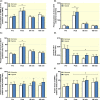Acute normobaric hypoxia blunts contraction-mediated mTORC1- and JNK-signaling in human skeletal muscle
- PMID: 34984845
- PMCID: PMC9285439
- DOI: 10.1111/apha.13771
Acute normobaric hypoxia blunts contraction-mediated mTORC1- and JNK-signaling in human skeletal muscle
Abstract
Aim: Hypoxia has been shown to reduce resistance exercise-induced stimulation of protein synthesis and long-term gains in muscle mass. However, the mechanism whereby hypoxia exerts its effect is not clear. Here, we examine the effect of acute hypoxia on the activity of several signalling pathways involved in the regulation of muscle growth following a bout of resistance exercise.
Methods: Eight men performed two sessions of leg resistance exercise in normoxia or hypoxia (12% O2 ) in a randomized crossover fashion. Muscle biopsies were obtained at rest and 0, 90,180 minutes after exercise. Muscle analyses included levels of signalling proteins and metabolites associated with energy turnover.
Results: Exercise during normoxia induced a 5-10-fold increase of S6K1Thr389 phosphorylation throughout the recovery period, but hypoxia blunted the increases by ~50%. Phosphorylation of JNKThr183/Tyr185 and the JNK target SMAD2Ser245/250/255 was increased by 30- to 40-fold immediately after the exercise in normoxia, but hypoxia blocked almost 70% of the activation. Throughout recovery, phosphorylation of JNK and SMAD2 remained elevated following the exercise in normoxia, but the effect of hypoxia was lost at 90-180 minutes post-exercise. Hypoxia had no effect on exercise-induced Hippo or autophagy signalling and ubiquitin-proteasome related protein levels. Nor did hypoxia alter the changes induced by exercise in high-energy phosphates, glucose 6-P, lactate or phosphorylation of AMPK or ACC.
Conclusion: We conclude that acute severe hypoxia inhibits resistance exercise-induced mTORC1- and JNK signalling in human skeletal muscle, effects that do not appear to be mediated by changes in the degree of metabolic stress in the muscle.
Keywords: FSR; Hippo pathway; deuterium oxide; muscle metabolites; oxygen.
© 2022 The Authors. Acta Physiologica published by John Wiley & Sons Ltd on behalf of Scandinavian Physiological Society.
Conflict of interest statement
The authors declare that they have no conflict of interests.
Figures









Comment in
-
The Art of Planning-How many samples are enough?Acta Physiol (Oxf). 2022 Feb;234(2):e13746. doi: 10.1111/apha.13746. Epub 2021 Dec 20. Acta Physiol (Oxf). 2022. PMID: 34907659 No abstract available.
-
How hypoxia blunts protein synthesis activation after resistance exercise.Acta Physiol (Oxf). 2022 Feb;234(2):e13747. doi: 10.1111/apha.13747. Epub 2021 Dec 29. Acta Physiol (Oxf). 2022. PMID: 34931453 No abstract available.
Similar articles
-
Contraction-regulated mTORC1 and protein synthesis: Influence of AMPK and glycogen.J Physiol. 2020 Jul;598(13):2637-2649. doi: 10.1113/JP279780. Epub 2020 May 27. J Physiol. 2020. PMID: 32372406
-
Effects of hypoxia on muscle protein synthesis and anabolic signaling at rest and in response to acute resistance exercise.Am J Physiol Endocrinol Metab. 2011 Oct;301(4):E697-702. doi: 10.1152/ajpendo.00276.2011. Epub 2011 Jul 12. Am J Physiol Endocrinol Metab. 2011. PMID: 21750270 Free PMC article.
-
Elevated plasma lactate levels via exogenous lactate infusion do not alter resistance exercise-induced signaling or protein synthesis in human skeletal muscle.Am J Physiol Endocrinol Metab. 2020 Oct 1;319(4):E792-E804. doi: 10.1152/ajpendo.00291.2020. Epub 2020 Aug 24. Am J Physiol Endocrinol Metab. 2020. PMID: 32830552
-
Autophagy is essential to support skeletal muscle plasticity in response to endurance exercise.Am J Physiol Regul Integr Comp Physiol. 2014 Oct 15;307(8):R956-69. doi: 10.1152/ajpregu.00187.2014. Epub 2014 Aug 13. Am J Physiol Regul Integr Comp Physiol. 2014. PMID: 25121614 Review.
-
Molecular Regulation of Skeletal Muscle Growth and Organelle Biosynthesis: Practical Recommendations for Exercise Training.Int J Mol Sci. 2021 Mar 8;22(5):2741. doi: 10.3390/ijms22052741. Int J Mol Sci. 2021. PMID: 33800501 Free PMC article. Review.
Cited by
-
Endurance exercise with reduced muscle glycogen content influences substrate utilization and attenuates acute mTORC1- and autophagic signaling in human type I and type II muscle fibers.Skelet Muscle. 2025 Mar 25;15(1):9. doi: 10.1186/s13395-025-00377-3. Skelet Muscle. 2025. PMID: 40128889 Free PMC article.
-
Does Exercise Regulate Autophagy in Humans? A Systematic Review and Meta-Analysis.Autophagy Rep. 2023 Mar 17;2(1):2190202. doi: 10.1080/27694127.2023.2190202. eCollection 2023. Autophagy Rep. 2023. PMID: 40395322 Free PMC article. Review.
-
Geniposide augments apoptosis in fibroblast-like synoviocytes by restoring hypoxia-enhanced JNK-BNIP3-mediated autophagy.Inflamm Res. 2023 Aug;72(8):1745-1760. doi: 10.1007/s00011-023-01782-4. Epub 2023 Aug 25. Inflamm Res. 2023. PMID: 37624402
References
-
- McKendry J, Breen L, Shad BJ, Greig CA. Muscle morphology and performance in master athletes: a systematic review and meta‐analyses. Ageing Res Rev. 2018;45:62‐82. - PubMed
-
- Filippin LI, Teixeira VN, da Silva MP, Miraglia F, da Silva FS. Sarcopenia: a predictor of mortality and the need for early diagnosis and intervention. Aging Clin Exp Res. 2015;27(3):249‐254. - PubMed
-
- Hoppeler H, Kleinert E, Schlegel C, et al. Morphological adaptations of human skeletal muscle to chronic hypoxia. Int J Sports Med. 1990;11(Suppl 1):S3‐S9. - PubMed
Publication types
MeSH terms
Substances
LinkOut - more resources
Full Text Sources
Research Materials

